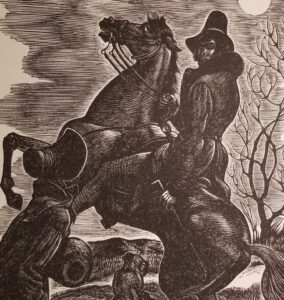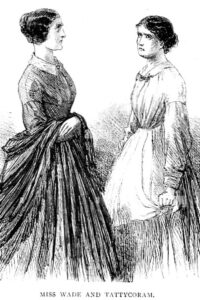
Jane Eyre and Mr. Rochester meet for the first time. Detail of engraving by Fritz Eichenberg from the 1943 Random House edition of “Jane Eyre” (1847) by Charlotte Brontë.
Victorian Desires
My work as a literary critic reflects my interests in how nineteenth-century British fiction conveys desire and pleasure, and how those dynamics shape Victorian realist narratives. Although my work typically focuses on desires that can be understood as transgressive, my overall goal is to illuminate how narrative longings function as both textual force and textual effect. I try to do this in original and intriguing ways that offer fresh readings of familiar texts.
Most recently, I have published on the ways in which the Elizabeth Gaskell novels Cranford (1853) and North and South (1854-1855) deploy the country-city dyad and the seemingly-conservative concept of nostalgia to articulate female desire.
“Sex and the Provincial Girl: Desire and Time in Elizabeth Gaskell’s Cranford and North and South” Nineteenth Century Gender Studies 15.3 (Winter 2019).
Thing Theory has helped me illuminate how textual deployments and descriptions of material objects structure desire in two Victorian texts: Charles Dickens’s travelogue Pictures from Italy (1846) and Ellen Wood’s incredibly popular 1861 “sensation” novel, East Lynne.
“Next Week!!—: Desire, Domestic Melodrama, and the Extravagant Proliferations of East Lynne” Victorian Literature and Culture, 43.4 (2015): 745-764.
“Some Thing(s) About Italy: Dickensian Objects, Interiors and Pleasures” Dickens Quarterly, 32.2 (2015): 139-152. Original archival research for this piece was supported by a Visiting Scholar Appointment at the Vittore Branca International Center for the Study of Italian Culture in Venice, Italy, in 2013.
Connections between inversion theory and racialized ideas around evolution and degeneration shape my exploration of the role of animals in the “first lesbian novel,” Radclyffe Hall’s The Well of Loneliness (1928).
“Stable Identity: Horses, Inversion Theory, and The Well of Loneliness,” LIT: Literature, Interpretation, Theory 18.4 (2008): 47-78

“Dickens’ Lesbian” Miss Wade exerts her dangerous influence over the maid Tattycoram in “Little Dorrit”(1855-1857). 1871 engraving by Sol Eytinge, Jr. for James Osgood Publishers, Boston.
My earlier work focuses specifically on female homoerotics and how classic Victorian novels organize the articulation of desire between women. Examples include:
“Reading A Head: Phrenology, Jane Eyre and the Homoerotics of Legibility,” Victorian Literature and Culture 33.1 (2005): 107-132.
“Multiplicities of Longing: The Queer Desires of Bleak House and Little Dorrit” Nineteenth Century Studies 18 (2004): 59-79.
“Pursuing Perfection: Dombey and Son, Female Homoerotic Desire, and the Sentimental Heroine,” Studies in the Novel 28 (1996): 281-302.